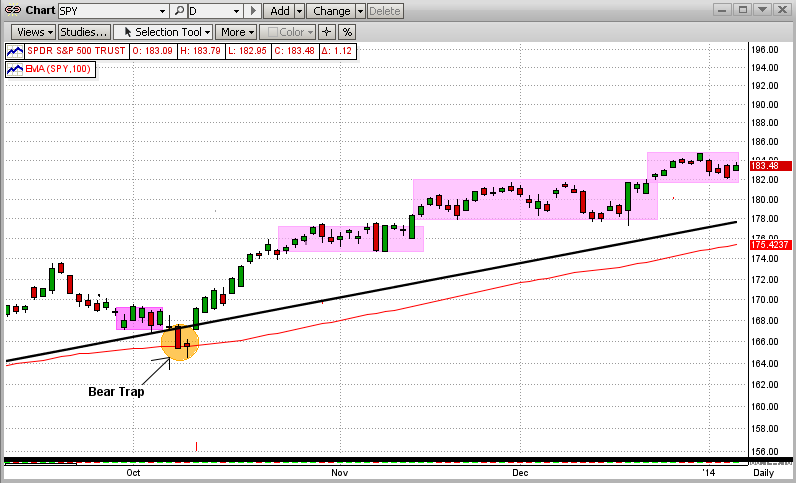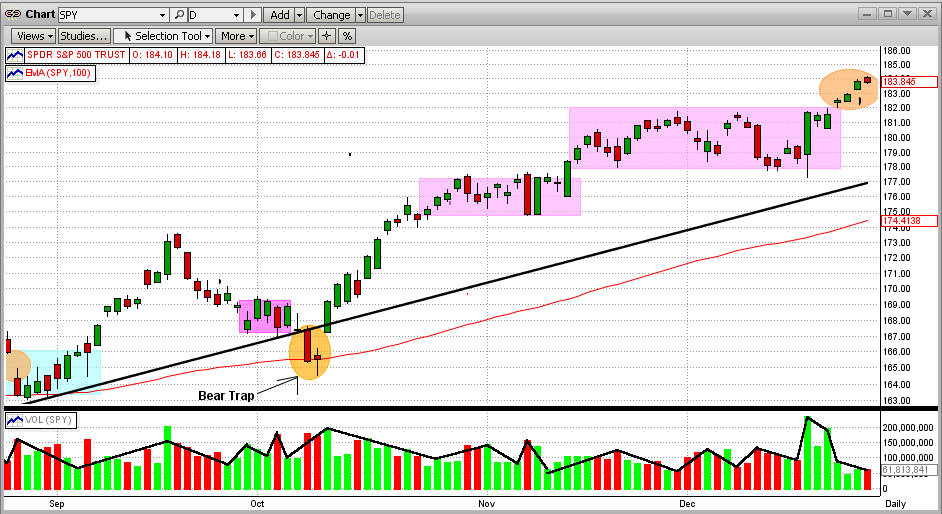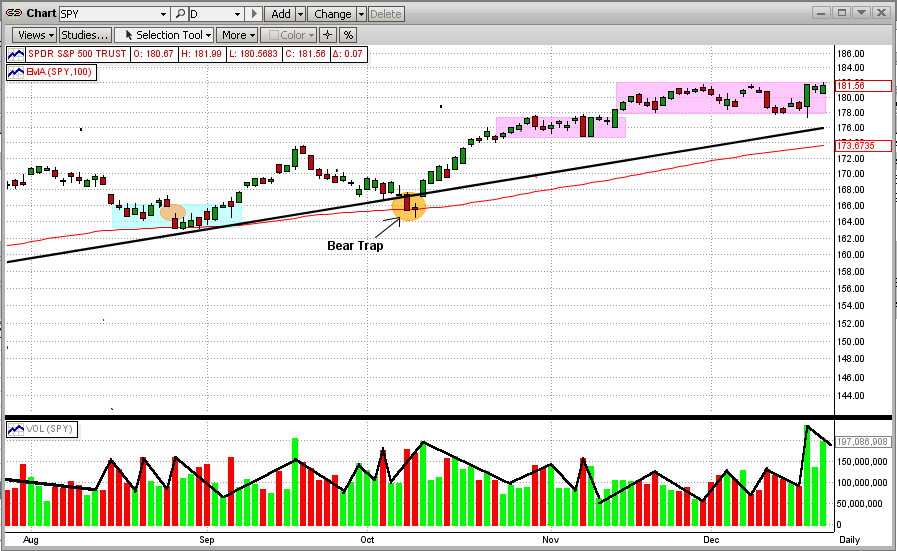I would like to examine the graph below from two different perspectives. One is from the MIPS viewpoint and the other is from the perspective of how the stock market behaves at the very end of one year and the beginning of the next. The second perspective has nothing to do with the MIPS models, but it is still very interesting because it does the same thing almost every year.
First, from the MIPS viewpoint, the graph below shows the third flat/sideways trading pattern for the SPY since the end of October 2013. In general, these sideways patterns will break out in the direction that they went in (all of the last three from the upside). The MIPS models called all of these correctly and stayed long. At this point, there is no indication of which way the SPY will break out of this new sideways trading pattern, but the odds are to the upside at this point (but, we all know that this can change in a matter of days).

Secondly, from the viewpoint of market behavior, the following phenomenon repeats time and time again.
1) The "Santa Claus Rally" is obviously a rally at the end of December. Many people feel that a major reason for this is that mutual funds buy "winners" in late December to include in their current year-end portfolio to make it appear as though they have owned these winners all year (and hence they show a portfolio of winners). This December, the SPY was up for the last seven trading days.
2) The "January Effect" is the belief (and subsequent behavior) that year-end bonuses are mostly paid in January, which leads to heavier individual buying, thus pushing the market higher. It usually works this way unless some unexpected bad news develops. However, the first few days of every January have a tendency to be down as investors dump their last-year winners to (a) protect their profits and (b) take their gains in the current year instead of in the prior year for tax reasons.
3) Watch for what is called the "January Barometer". This term results from the fact that statistically, the market performance in any given year mimics the market performance in January of that year. For example, if the market is up in January of any given year, there is roughly a 90% chance that the market will be up for that year (and vice versa, of course). This statistic is from the years 1950-2013. The saying for this is "As goes January, so goes the rest of the year".
Blog from 12/29/2013
In our previous blog below from 12/22/13, we showed how the SPY had climbed quickly back to the top of its flat/sideways trading pattern on high volume. From this one could conclude that we should have expected a "breakout" to the upside this past week. As can be seen in the graph immediately below, we did get an upside breakout this past week, but not what we would call a really strong breakout. This is mainly because of its low volume. The odds are for this breakout to pick up steam and head higher, but it could very easily turn out to be a "bull trap" that turns lower in the short term. It is exactly these kinds of situations when we need for MIPS to tell us what to do.

Blog from 12/22/2013
In our previous blog (from 12/16/13), we told our MIPS members to basically ignore the 5-consecutive-day drop in the SPY that occurred in the previous week (see the last graph below). The reasons for this were: (a) the entire drop was just a little over 2% and (b) the market was just completing a drop from the top to the bottom of a relatively flat/sideways 15-day trading pattern.
Then this last week, the SPY basically reversed it movement and simply went back to the top of the trading pattern (see graph immediately below). No breakout. So, is this week's move up any different than last week's move down? In many cases, the answer would be no. But, there are some compelling reasons for believing that the recent move up was indeed more telling than the previous move down, even though there was no breakout. One reason is that the trading pattern is now over 20 days old, and sideways trading patterns usually do not last much longer than that. But the BIG reason to think that this move up is different from the prior moves is that the move up was on volume almost two time higher than the volume for the prior 30 days. Thus, one can conclude that the move up was the result of the big guys buying. That's huge!!!
The real story will most likely unfold within the next week or two, so let's stay long and wait for MIPS to tell us what to do next.
